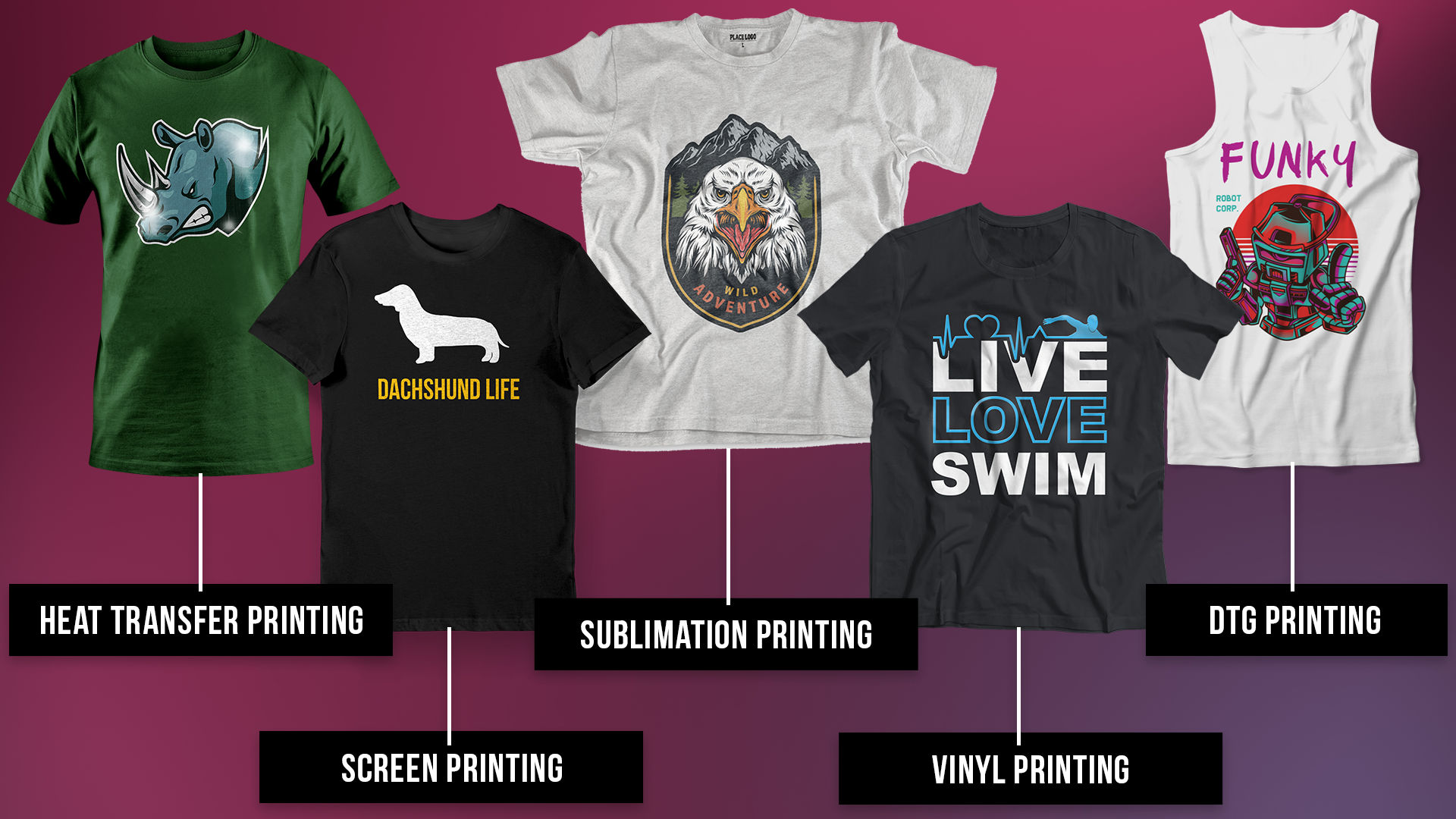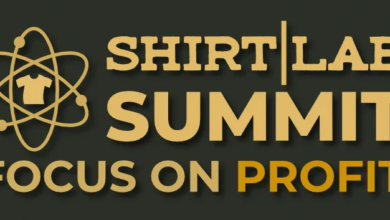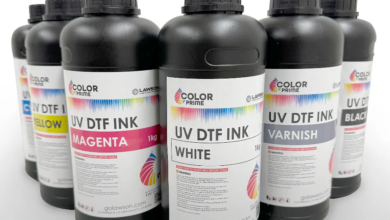Have you been thinking about starting an apparel printing business or expanding your custom apparel business? Making that decision requires you to spend some time learning about the options and methods available. To save you some time, here’s the breakdown in one post.
The most popular printing methods:
- DTG Printing
- Screen Printing
- Sublimation Printing
- Heat Printing (transfer/vinyl)
Each printing method has its pros and cons, and not all of them will fit your needs, but here’s some information to help you decide which printing method is right for your custom apparel business.
1. DTG Printing
DTG, also known as direct-to-garment printing, is a newer printing method where you print directly onto garments like T-shirts, jacket backs, tank tops, and more. To create a custom design on a T-shirt, you need a DTG printer, pretreatment liquid, and a heat press or conveyor dryer.
A DTG printer works the same as an inkjet printer you would find at home or an office. Instead of dropping ink onto paper like a regular printer, a DTG printer drops special garment ink directly onto the fabric. To use the DTG printing method, you have to pretreat the garment before loading it into the printer. Pretreatment is necessary for the ink to adhere better to the fabric. Pretreating also prevents ink from soaking into the garment and helps the designs last longer.
Once loaded, the design is printed onto the garment. The last thing you need to do is cure the design, which is when you dry or harden the design’s ink, so it adheres properly to the garment. You do this with a heat press or a conveyor dryer to ensure the design can withstand many washes and prevent it from fading too quickly.
Pros
- Easily create customizable designs and products
- Outputs high-quality photorealistic designs
- Designs can last 50 washes
- Printing process is nearly mess-free
- Fast option for bulk orders with different designs
- Change between designs easily on the printer’s control panel
Cons
- Pretreating the garments before printing them
- Ink cost varies depending on the color, size, complexity of the design, and what product you’re printing on
Learn more:
- DTG Printing: Ink, Pretreatment, and Curing
- Overcome the Top 5 Challenges of DTG Printing
- DTG Curing: Conveyor Dryer vs. Heat Press
2. Screen Printing
Screen printing is a very traditional printing technique that is a bit more labor-intensive than others. This is because you have to push ink through a stencil onto the fabric manually.
First, you have to get a screen made, which is basically a stencil of the design you want. Once you have the screen ready to go, you either load your shirt onto a manual press or table, load your ink onto the screen, and push the ink through the screen onto the fabric. This is the simplified version, but the process involves many prep and setup steps.
Pros
- Cost-effective for large batches of one design
- Quick option if printing 50 shirts with the same design (even faster if you have multiple screens of the same design)
- Print versatility (on various locations of a garment and on materials, like wood, glass, and banners)
- Designs can last as long as the garment
Cons
- Requires a screen for each design and color, which can get expensive (time and money)
- Need the right space for the equipment
- The messiest of the apparel decorating options
Learn more:
- Screen Printing Basics: Burning Images
- Screen-Printing Basics: Ink Preparation and Storage
- Manual vs. Automatic Press: Which One is Right for You?
- The Big Debate: Push or Pull the Squeegee
3. Sublimation Printing
Sublimation is a printing method where special ink is transferred from paper to the garment using a heat press. To do this method, you need a printer that uses sublimation ink.
When the ink from the transfer is heated via the heat press, the ink on the transfer paper goes from a solid to a gas and embeds itself into the fabric. When it cools, it goes back to being a solid and becomes a permanent part of the material.
Pros
- The design embeds into the fabric, lasting much longer than designs using other printing methods
- Bright, high-quality designs without a layer or rough “hand feel” on top of the fabric
- Sublimation works on hard objects like mugs
Cons
- Only works with polyester or high poly-blend garments and white or light-colored garments
- Hard objects must be polyester-coated objects
- Possibility of dye migration
Learn more:
- A Word on Sublimation and Dye Migration
- 4 Causes of Burn Marks in Sublimation
- Getting Started in Small-Format Sublimation
- For the Health of Your Sublimation Printer
4. Vinyl/Heat Transfer Printing
Vinyl printing is when you cut out a vinyl design and transfer it onto fabric with a heat press. You commonly see vinyl on sports jerseys, but they are used on pretty much anything, from T-shirts to totes.
To do vinyl printing, you start by connecting a vinyl cutter/plotter to your computer to cut out the designs. Once you print out the design, you need to weed it (remove the excess material from the design). Then you put it on your garment and heat press it to adhere it to the fabric.
Heat transfer printing involves printing a design on a sheet of transfer paper, then transferring it onto an adhesive paper using a heat press. After that, you peel away the adhesive sheet from the transfer sheet and then press the design onto the garment.
Pros
- Being able to place the design anywhere on the garment
- Low cost to entry
- Small batches profitable
- Great for any garments and surfaces like cotton, polyester, ceramic, wood, metal, etc.
- Sharp and vibrant designs
- Cost-efficient for small to medium-sized orders
Cons
- Not scalable and time-consuming for large orders
- Not cost-effective for 15 or more garments
- Vinyl can crack
- Transfers can fade over time
Although materials are affordable and great for small jobs, in the same amount of time you cut vinyl or print transfers for a large order of 50 shirts, you could have done double that or more with a different printing method.
Learn more:
- Your Guide to Heat Transfer Placement
- 5 Holiday Heat Transfer Designs to Try This Year
- 10 Rules for Web Store Order Fulfillment with Heat Transfers
- How to Check Heat Transfers and Fabric for Compatibility
Bottom line
DTG printing, screen printing, sublimation printing, and heat printing have their advantages and disadvantages. The most important thing is to make sure to do your research before investing in any printing method.
Reach out to experts and other printing business owners to see what their opinions are of each method.
Think about how much money and time you can afford to invest in your printing setup, what you want to print, and who your customer base is before making a final decision.





